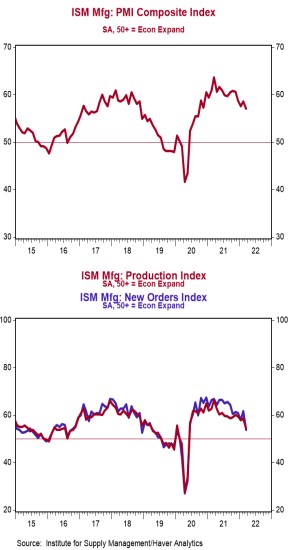- The ISM Manufacturing Index declined to 57.1 in March, missing the consensus expected 59.0. (Levels higher than 50 signal expansion; levels below 50 signal contraction.)
- The major measures of activity were mixed in March, but all stand above 50, signaling growth. The production index fell to 54.5 from 58.5 in March, while the new orders index declined to 53.8 from 61.7. The employment index rose to 56.3 from 52.9, and the supplier deliveries index fell to 65.4 from 66.1 in March.
- The prices paid index rose to 87.1 in March from 75.6 in February.
Implications:
The manufacturing sector continued to expand in March, though at a slightly slower pace, with fifteen of eighteen industries reporting growth. The two most forward-looking indices, new orders and production, led the overall index lower in March. In fact, new orders posted the largest monthly decline since the early days of the COVID pandemic, most likely a result of short-term customer uncertainty in the immediate aftermath of the Russian invasion of Ukraine. That said, that index is still north of 50, signaling growth, and respondent comments in March highlighted strong ongoing demand from customers while also reiterating supply-chain problems related to shortages of key inputs and transportation services. These issues have all come together to keep manufacturing activity from rising quickly enough to meet an explosion of demand. However, there has been recent progress on several fronts. For example, the supplier deliveries index fell for the fourth time in five months and is well below its recent high back in May 2021, signaling that supply-chain issues are easing. However, delays are far from over, with fifteen of eighteen industries reporting waiting longer for inputs. This, in turn, has resulted in long lead times for the clients of US factories, who continued to see their inventories shrink in March. The good news is that the rate at which those inventories are shrinking has been slowing consistently. There was also improvement on the labor front, with the employment index rising to 56.3, just below the post-pandemic high of 57.7 set in March of 2021. It looks like the manufacturing sector, which is one of the worst-hit sectors in the ongoing labor shortage, has begun to see some progress on filling positions. Job openings are now down over 100,000 from the peak, but are still twice what they were pre-pandemic, signaling the sector still has a way to go. Finally, the highest reading of any index in March continued to come from prices, which posted its largest monthly gain in over a year, surging to 87.1 in March from 75.6 in February. It looks like the invasion of Ukraine temporarily boosted inflationary pressure over and above pre-existing inflation related to an overly expansionary Federal Reserve. Inflation this year will ultimately moderate from the pace we saw last year, but not just yet. In other news this morning, construction spending rose 0.5% in February (+1.6% including revisions to prior months), with large increases in home building and power projects more than offsetting declines in commercial construction and roads.





